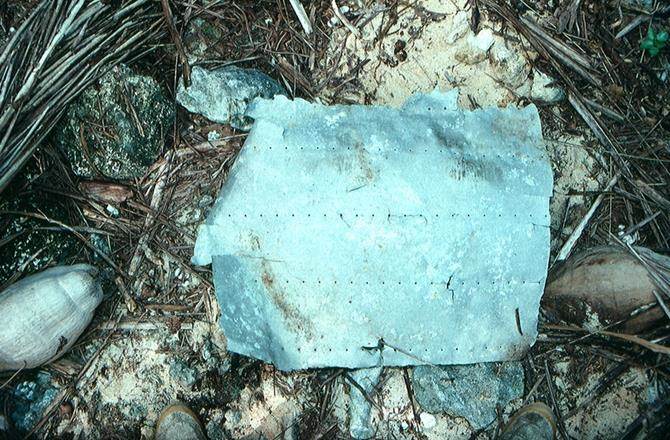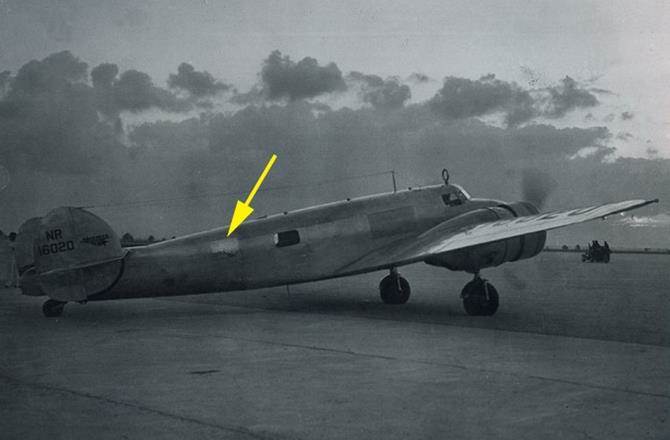It looks like you're using an Ad Blocker.
Please white-list or disable AboveTopSecret.com in your ad-blocking tool.
Thank you.
Some features of ATS will be disabled while you continue to use an ad-blocker.
11
share:
A fragment of Amelia Earhart's lost aircraft has been identified to a high degree of certainty for the first time ever since her plane vanished over the Pacific Ocean on July 2, 1937, in a record attempt to fly around the world at the equator.
New research strongly suggests that a piece of aluminum aircraft debris recovered in 1991 from Nikumaroro, an uninhabited atoll in the southwestern Pacific republic of Kiribati, does belong to Earhart’s twin-engined Lockheed Electra.
The breakthrough would prove that, contrary to what was generally believed, Earhart and her navigator, Fred Noonan, did not crash in the Pacific Ocean, running out of fuel somewhere near their target destination of Howland Island.
Amelia Earhart plane fragment identified
Instead, they made a forced landing on Nikumaroro's smooth, flat coral reef. The two became castaways and eventually died on the atoll, which is some 350 miles southeast of Howland Island.
In 10 archaeological expeditions to Nikumaroro, Gillespie and his team uncovered a number of artifacts which, combined with archival research, provide strong circumstantial evidence for a castaway presence.
New Research Focuses TIGHAR’s Underwater Search for Earhart Plane
More at source, please move to appropriate place or delete if duplicate. Read the source for more information.
i think claims like this are made at least once every year, lets see this one
the piece of aluminum in question

the place from were it came

The yellow arrow indicates where an aluminum patch was installed on Amelia Earhart's airplane during a repair stop in Miami.
edit on
29-10-2014 by Indigent because: (no reason given)
a reply to: Indigent
If they lived for awhile with no hope of rescue I hope they got their groove on a few times. Interesting find, but after ten expeditions this team may be grasping for anything to prove their theory, so I won't accept it totally until a body part is found (the one who died first must have done some kind of burial, or "dinner" as it's called in polite circles).
If they lived for awhile with no hope of rescue I hope they got their groove on a few times. Interesting find, but after ten expeditions this team may be grasping for anything to prove their theory, so I won't accept it totally until a body part is found (the one who died first must have done some kind of burial, or "dinner" as it's called in polite circles).
edit on 29-10-2014 by Aleister because: (no reason given)
With no fresh water source on the island I imagine they died of dehydration not long after they used up whatever supply they had on the plane. IIRC
there is very little, if any, shade on that island, which would hasten the dehydration. Nothing really to eat either, unless you count raw crab, and
that would also more than likely further hasten dehydration (through vomiting). Add sunburn to the list. Fall asleep and wake to crabs peeling off
chunks of your flesh. Not a pleasant way to perish.
I do hope this is true, but it is kind of sad.. I've read about this theory and it even has them trying radio communication for a time.. some signals
were detected and I believe reading that search times were near this island .. the sad part is that if search parties had combed that area more, she
and her navigator may have survived.
a reply to: Cohen the Barbarian
With any number of plane parts and containers, getting fresh water from sea water would have been no problem (evap/condense). It would be especially easy if they had fire. The lack of apparent shelter and food would be a bigger concern. Needless to say, it would be a crummy existence, but not impossible.
With any number of plane parts and containers, getting fresh water from sea water would have been no problem (evap/condense). It would be especially easy if they had fire. The lack of apparent shelter and food would be a bigger concern. Needless to say, it would be a crummy existence, but not impossible.
a reply to: Indigent
It may lay to rest one of the most controversial theory's but then again it may not, was amelia killed by the japanese.
Sorry bad link here is another.
www.broomfieldenterprise.com...
There were several witness who claimed to have seen a western woman matching amelias description beheaded by the japanese.
If it was not her then it must have been another western woman.
It may lay to rest one of the most controversial theory's but then again it may not, was amelia killed by the japanese.
Sorry bad link here is another.
www.broomfieldenterprise.com...
There were several witness who claimed to have seen a western woman matching amelias description beheaded by the japanese.
If it was not her then it must have been another western woman.
edit on 29-10-2014 by LABTECH767 because: (no reason given)
a reply to: Halfswede
As I understand it the plane, over a relatively short period of time, was moved by wave action and/or tides until it slipped off the edge of the reef, leaving little time to strip enough parts to build a solar still. And it would have to be a solar still, because there is no vegetation on the island to burn, and they went down because they ran out of gas. You have two people on an island where the average temperature is probably in the high 80s with humidity to match and no shade. They would need something like a gallon each per day to survive for any length of time, and it would be darn hard to build a solar still from scrap aluminum that could provide two gallons per day of fresh water. Putting the issue of water aside they were still subject to unrelenting sun (no sunscreen back then and no shade), wind (helps with dehydration), and a lack of food. They might have lasted two weeks, but I doubt it. If nothing else got them, the sun would have burned them to a crisp.
As I understand it the plane, over a relatively short period of time, was moved by wave action and/or tides until it slipped off the edge of the reef, leaving little time to strip enough parts to build a solar still. And it would have to be a solar still, because there is no vegetation on the island to burn, and they went down because they ran out of gas. You have two people on an island where the average temperature is probably in the high 80s with humidity to match and no shade. They would need something like a gallon each per day to survive for any length of time, and it would be darn hard to build a solar still from scrap aluminum that could provide two gallons per day of fresh water. Putting the issue of water aside they were still subject to unrelenting sun (no sunscreen back then and no shade), wind (helps with dehydration), and a lack of food. They might have lasted two weeks, but I doubt it. If nothing else got them, the sun would have burned them to a crisp.
a reply to: Cohen the Barbarian
Assuming they knew how to make a solar still in the first place.
According to the wiki article on the island there is fresh water available in the form of an "unreliable lens" - but it may not have ben working, or they may not have known of it if they did get there. 24 men from the SS Norwich were able to survive on eth island for several days in 1929 although they did receive supplies from ships outside the reef.
Assuming they knew how to make a solar still in the first place.
According to the wiki article on the island there is fresh water available in the form of an "unreliable lens" - but it may not have ben working, or they may not have known of it if they did get there. 24 men from the SS Norwich were able to survive on eth island for several days in 1929 although they did receive supplies from ships outside the reef.
edit on 30-10-2014 by Aloysius the Gaul because: (no reason given)
new topics
-
Petition Calling for General Election at 564,016 and rising Fast
Social Issues and Civil Unrest: 2 hours ago -
Rep. Alexandria O. Cortez Says Forcing People to Use The Correct Bathroom is Dangerous.
US Political Madness: 9 hours ago -
Cooperation zones
World War Three: 10 hours ago -
Ok this is some BS now WTH
Rant: 11 hours ago
top topics
-
France gives Ukraine license to fire long-range missiles at Russia
World War Three: 14 hours ago, 9 flags -
Rep. Alexandria O. Cortez Says Forcing People to Use The Correct Bathroom is Dangerous.
US Political Madness: 9 hours ago, 5 flags -
Petition Calling for General Election at 564,016 and rising Fast
Social Issues and Civil Unrest: 2 hours ago, 5 flags -
Ok this is some BS now WTH
Rant: 11 hours ago, 4 flags -
Cooperation zones
World War Three: 10 hours ago, 3 flags -
Stalker 2 - Review from a Veteran
Video Games: 17 hours ago, 2 flags
active topics
-
Jaguar Rebrand Video Causes "WTF?" Moment - Seriously Weird
Automotive Discussion • 31 • : BasicResearchMethods -
Biden's "Reckless" Decision To Escalate Russia-Ukraine War
World War Three • 124 • : PrivateAngel -
Well, here we go red lines crossed Biden gives the go ahead to use long range missiles
World War Three • 337 • : Tolkien -
Well we know Putins ICBMs won't fail in their silos
World War Three • 213 • : Xtrozero -
Petition Calling for General Election at 564,016 and rising Fast
Social Issues and Civil Unrest • 12 • : gortex -
Rep. Alexandria O. Cortez Says Forcing People to Use The Correct Bathroom is Dangerous.
US Political Madness • 21 • : UpIsNowDown2 -
Congress 2024 - We do not want me in our ladies rooms
US Political Madness • 21 • : TheSingleBillie -
Results of the use of the Oreshnik missile system in Dnepropetrovsk
World War Three • 166 • : Oldcarpy2 -
Cooperation zones
World War Three • 14 • : nugget1 -
France gives Ukraine license to fire long-range missiles at Russia
World War Three • 20 • : 38181
11

